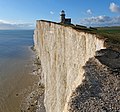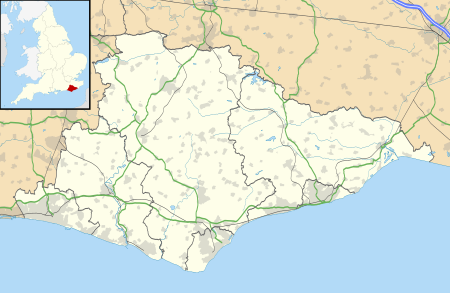Portal:East Sussex

East Sussex is a ceremonial county in South East England. It is bordered by Kent to the north-east, West Sussex to the west, Surrey to the north-west, and the English Channel to the south. The largest settlement is the city of Brighton and Hove, and the county town is Lewes.
The county has an area of 1,792 km2 (692 sq mi) and a population of 822,947. The latter is largely concentrated along the coast, where the largest settlements are located: Brighton and Hove (277,105), Eastbourne (99,180), and Hastings (91,490). The centre and north of the county are largely rural, and the largest settlement is Crowborough (21,990). For local government purposes, East Sussex comprises a non-metropolitan county, with five districts, and the unitary authority of Brighton and Hove. East Sussex and West Sussex historically formed a single county, Sussex.
East Sussex is part of the historic county of Sussex, which has its roots in the ancient kingdom of the South Saxons, who established themselves there in the 5th century AD, after the departure of the Romans. Archaeological remains are plentiful, especially in the upland areas. The area's position on the coast has also meant that there were many invaders, including the Romans and later the Normans, following the defeat of the English army by William the Conquerer at the Battle of Hastings in 1066. Earlier industries included fishing, iron-making, and the wool trade, all of which have declined or been lost completely. (Full article...)
Selected article
Ashdown Forest is an ancient area of open heathland occupying the highest sandy ridge-top of the High Weald Area of Outstanding Natural Beauty. It is situated some 30 miles (48 km) south of London in the county of East Sussex, England. Rising to an elevation of 732 feet (223 m) above sea level, its heights provide expansive vistas across the heavily wooded hills of the Weald to the chalk escarpments of the North Downs and South Downs on the horizon.
Ashdown Forest's origins lie as a medieval hunting forest created soon after the Norman conquest of England. By 1283 the forest was fenced in by a 23 miles (37 km) pale enclosing an area of some 20 square miles (52 km2; 13,000 acres; 5,200 ha). Thirty-four gates and hatches in the pale, still remembered in place names such as Chuck Hatch and Chelwood Gate, allowed local people to enter to graze their livestock, collect firewood, and cut heather and bracken for animal bedding. The forest continued to be used by the monarchy and nobility for hunting into Tudor times, including notably Henry VIII, who had a hunting lodge at Bolebroke Castle, Hartfield and who courted Anne Boleyn at nearby Hever Castle.
Ashdown Forest has a rich archaeological heritage. It contains much evidence of prehistoric human activity, with the earliest evidence of human occupation dating back to 50,000 years ago. There are important Bronze Age, Iron Age, and Romano-British remains. The forest was the centre of a nationally important iron industry on two occasions, during the Roman occupation of Britain and in the Tudor period when, in 1496, England's first blast furnace was built at Newbridge, near Coleman's Hatch, marking the beginning of Britain's modern iron and steel industry. In 1693, more than half the forest was taken into private hands, with the remainder set aside as common land. The latter today covers 9.5 square miles (25 km2; 6,100 acres; 2,500 ha) and is the largest area with open public access in South East England. The ecological importance of Ashdown Forest's heathlands is reflected by its designation as a Site of Special Scientific Interest, as a Special Protection Area for birds, and as a Special Area of Conservation for its heathland habitats. It is part of the European Natura 2000 network as it hosts some of Europe's most threatened species and habitats.
Ashdown Forest is famous for serving as inspiration for the Hundred Acre Wood, the setting for the Winnie-the-Pooh stories written by A. A. Milne. Milne lived on the northern edge of the forest and took his son, Christopher Robin, walking there. The artist E. H. Shepard drew on the landscapes of Ashdown Forest as inspiration for many of the illustrations he provided for the Pooh books. (Full article...)
Selected images
Selected biography
Norman Quentin Cook (born Quentin Leo Cook, 31 July 1963), also known by his stage name Fatboy Slim (among others), is an English musician, DJ, and record producer who helped to popularise the big beat genre in the 1990s. In the 1980s, Cook was the bassist for the Hull-based indie rock band the Housemartins, who achieved a UK number-one single with their a cappella cover of "Caravan of Love". After the Housemartins split up, Cook formed the electronic band Beats International in Brighton, who produced the number-one single "Dub Be Good to Me". He then played in Freak Power, Pizzaman, and the Mighty Dub Katz with moderate success.
In 1996, Cook adopted the name Fatboy Slim and released Better Living Through Chemistry to critical acclaim. Follow-up albums You've Come a Long Way, Baby, Halfway Between the Gutter and the Stars, and Palookaville, as well as singles such as "The Rockafeller Skank", "Praise You", "Right Here, Right Now", "Weapon of Choice", and "Wonderful Night", achieved commercial and critical success. In 2008, Cook formed the Brighton Port Authority, a collaborative effort with a number of other established artists including David Byrne. He has been responsible for successful remixes for Cornershop, the Beastie Boys, A Tribe Called Quest, Groove Armada, and Wildchild.
It was reported in 2008 that Cook held the Guinness World Record for most top-40 hits under different names. As a solo act, he has won a Grammy Award, nine MTV Video Music Awards and two Brit Awards, and was nominated for the Tony Award for Best Original Score in 2024. (Full article...)
Did you know that
General images -
List articles

- List of hills of East Sussex
- List of local nature reserves in East Sussex
- List of monastic houses in East Sussex
- List of museums in East Sussex
- List of Parliamentary constituencies in East Sussex
- List of places in East Sussex
- List of settlements in East Sussex by population
- List of Sites of Special Scientific Interest in East Sussex
- List of windmills in East Sussex
Subcategories
Settlements map
Things you can do
- Add to this portal.
- Join the Sussex WikiProject
Topics
Related portals
Associated Wikimedia
The following Wikimedia Foundation sister projects provide more on this subject:
-
Commons
Free media repository -
Wikibooks
Free textbooks and manuals -
Wikidata
Free knowledge base -
Wikinews
Free-content news -
Wikiquote
Collection of quotations -
Wikisource
Free-content library -
Wikiversity
Free learning tools -
Wikivoyage
Free travel guide -
Wiktionary
Dictionary and thesaurus

























































































